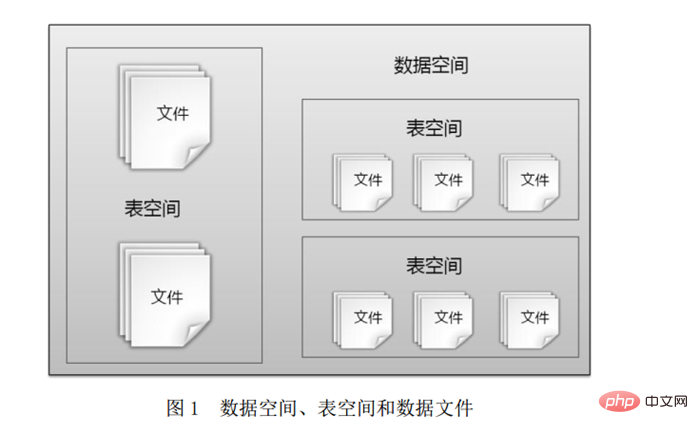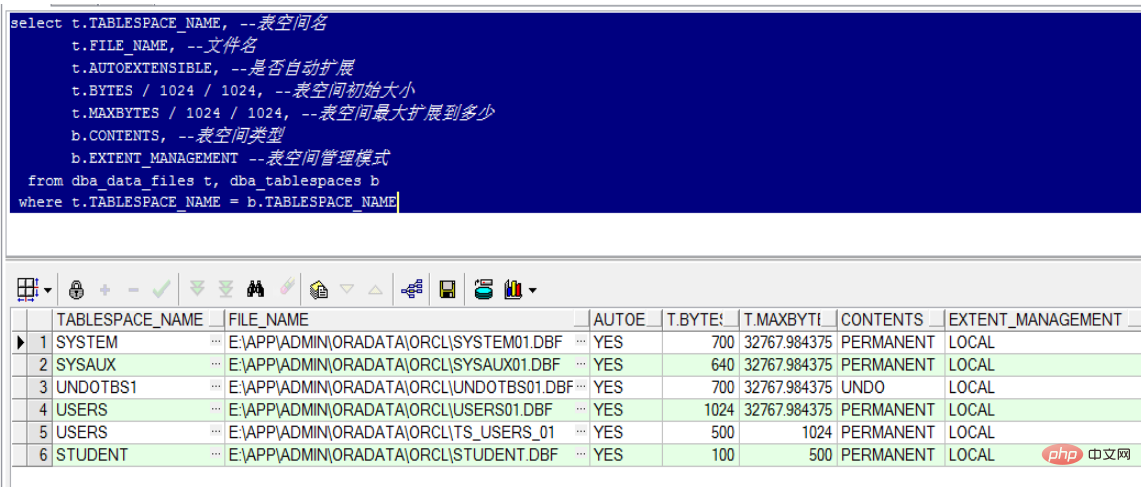What is table space in oracle
In Oracle, table space is a container for Oracle data objects and data storage. It is a logical concept. Several operating system files can form a table space. Table spaces uniformly manage data files in the space. One data file can only belong to one table space; and a database space consists of several table spaces.

The operating environment of this tutorial: Windows 7 system, Oracle 11g version, Dell G3 computer.
Oracle Table Space
In the database system, storage space is a more important resource. Proper use of space can not only save space, but also improve the system. efficiency and work performance.
Oracle can store massive amounts of data, and all data is stored in data files. The size of data files is limited by the operating system, and overly large data files have a great impact on data access performance. At the same time, Oracle is a cross-platform database. Oracle data can be easily transplanted on different platforms. So how can we provide large capacity in a unified access format? Oracle uses table spaces to solve this problem.
Table space is a container for Oracle data objects and data storage. It is just a logical concept. Several operating system files (the files may not be very large) can form a table space. Table spaces uniformly manage data files in the space, and one data file can only belong to one table space. A database space consists of several table spaces. As shown in the figure:

All data in Oracle (including system data) are all stored in table spaces. Common table spaces are:
-
System table space:
Stores system data. The system table space is created when the database is created. The table space name is SYSTEM. Stores important system data information such as data dictionaries, views, and database structures. If the SYSTEM space is insufficient during operation, the impact on the database will be greater. Although the space can be expanded through commands during system operation, it will still affect the performance of the database, so It is necessary to set the data file appropriately when creating the database.
-
TMEP table space:
Temporary table space is created when installing the database. The temporary table space can be increased through commands at runtime. The important role of the temporary table space is data sorting. For example, after the user executes a command such as Order by, the server needs to sort the selected data. If the data is large, the sorting area of the memory may not be able to hold the data, so some intermediate sorting results need to be written to the temporary storage area of the hard disk. in the table space.
-
User table custom space:
Users can create table spaces through the CREATE TABLESPACE command
Create tables Space
The syntax structure of Oracle's creation of table space is as follows:
create tablespace tab_name datafile 'filename' size n [autoextend on next n1 maxsize m /of] [permanent] [extent management local/dictionary];
Syntax analysis:
create tablespace: keyword to create table space.
tab_name: The name of the table space after creation.
datafile: Specify the path of the data file as filename.
size n: Specify the size of the data file.
[autoextend on next n1 maxsize m /of ]: Indicates whether the table space is automatically expanded, on means automatic expansion, of means no expansion, when automatically extended, next n1 means The size of automatic expansion, max size m means that the data file can be expanded to a maximum size of m.
[permanent]: Indicates the type of table space created. Permanent indicates permanent table space. If not filled in, the default permanent table space will be used.
[extent management local/dictionary]: Indicates the table space management method, local indicates the local management mode, and dictionary indicates the data dictionary management mode. The default is local management mode.
Case 1, According to the table space creation syntax, create a table space student with a 100M size data file (student.dbf). The code is as follows:
create tablespace student datafile 'E:\APP\ADMIN\ORADATA\ORCL\student.DBF' size 100m autoextend on next 10m maxsize 500m permanent extent management local;
Case analysis:
Create a student table space and specify the data file as "E:\APP\ADMIN\ORADATA\ORCL\student.DBF". The table space is automatically expanded every time. The extension size is 10M, and the maximum extension is 500M. A permanent table space is created to store the database objects and data of the student user. The management mode is local management.
We check the data dictionary dba_data_files and dba_tablespaces to query the created student table space. The query code is as follows:
select t.TABLESPACE_NAME, --表空间名
t.FILE_NAME, --文件名
t.AUTOEXTENSIBLE, --是否自动扩展
t.BYTES / 1024 / 1024, --表空间初始大小
t.MAXBYTES / 1024 / 1024, --表空间最大扩展到多少
b.CONTENTS, --表空间类型
b.EXTENT_MANAGEMENT --表空间管理模式
from dba_data_files t, dba_tablespaces b
where t.TABLESPACE_NAME = b.TABLESPACE_NAME
Recommended tutorial: "OracleTutorial》
The above is the detailed content of What is table space in oracle. For more information, please follow other related articles on the PHP Chinese website!

Hot AI Tools

Undresser.AI Undress
AI-powered app for creating realistic nude photos

AI Clothes Remover
Online AI tool for removing clothes from photos.

Undress AI Tool
Undress images for free

Clothoff.io
AI clothes remover

Video Face Swap
Swap faces in any video effortlessly with our completely free AI face swap tool!

Hot Article

Hot Tools

Notepad++7.3.1
Easy-to-use and free code editor

SublimeText3 Chinese version
Chinese version, very easy to use

Zend Studio 13.0.1
Powerful PHP integrated development environment

Dreamweaver CS6
Visual web development tools

SublimeText3 Mac version
God-level code editing software (SublimeText3)

Hot Topics
 What to do if the oracle can't be opened
Apr 11, 2025 pm 10:06 PM
What to do if the oracle can't be opened
Apr 11, 2025 pm 10:06 PM
Solutions to Oracle cannot be opened include: 1. Start the database service; 2. Start the listener; 3. Check port conflicts; 4. Set environment variables correctly; 5. Make sure the firewall or antivirus software does not block the connection; 6. Check whether the server is closed; 7. Use RMAN to recover corrupt files; 8. Check whether the TNS service name is correct; 9. Check network connection; 10. Reinstall Oracle software.
 How to solve the problem of closing oracle cursor
Apr 11, 2025 pm 10:18 PM
How to solve the problem of closing oracle cursor
Apr 11, 2025 pm 10:18 PM
The method to solve the Oracle cursor closure problem includes: explicitly closing the cursor using the CLOSE statement. Declare the cursor in the FOR UPDATE clause so that it automatically closes after the scope is ended. Declare the cursor in the USING clause so that it automatically closes when the associated PL/SQL variable is closed. Use exception handling to ensure that the cursor is closed in any exception situation. Use the connection pool to automatically close the cursor. Disable automatic submission and delay cursor closing.
 How to create cursors in oracle loop
Apr 12, 2025 am 06:18 AM
How to create cursors in oracle loop
Apr 12, 2025 am 06:18 AM
In Oracle, the FOR LOOP loop can create cursors dynamically. The steps are: 1. Define the cursor type; 2. Create the loop; 3. Create the cursor dynamically; 4. Execute the cursor; 5. Close the cursor. Example: A cursor can be created cycle-by-circuit to display the names and salaries of the top 10 employees.
 How to stop oracle database
Apr 12, 2025 am 06:12 AM
How to stop oracle database
Apr 12, 2025 am 06:12 AM
To stop an Oracle database, perform the following steps: 1. Connect to the database; 2. Shutdown immediately; 3. Shutdown abort completely.
 What steps are required to configure CentOS in HDFS
Apr 14, 2025 pm 06:42 PM
What steps are required to configure CentOS in HDFS
Apr 14, 2025 pm 06:42 PM
Building a Hadoop Distributed File System (HDFS) on a CentOS system requires multiple steps. This article provides a brief configuration guide. 1. Prepare to install JDK in the early stage: Install JavaDevelopmentKit (JDK) on all nodes, and the version must be compatible with Hadoop. The installation package can be downloaded from the Oracle official website. Environment variable configuration: Edit /etc/profile file, set Java and Hadoop environment variables, so that the system can find the installation path of JDK and Hadoop. 2. Security configuration: SSH password-free login to generate SSH key: Use the ssh-keygen command on each node
 What to do if the oracle log is full
Apr 12, 2025 am 06:09 AM
What to do if the oracle log is full
Apr 12, 2025 am 06:09 AM
When Oracle log files are full, the following solutions can be adopted: 1) Clean old log files; 2) Increase the log file size; 3) Increase the log file group; 4) Set up automatic log management; 5) Reinitialize the database. Before implementing any solution, it is recommended to back up the database to prevent data loss.
 Oracle's Role in the Business World
Apr 23, 2025 am 12:01 AM
Oracle's Role in the Business World
Apr 23, 2025 am 12:01 AM
Oracle is not only a database company, but also a leader in cloud computing and ERP systems. 1. Oracle provides comprehensive solutions from database to cloud services and ERP systems. 2. OracleCloud challenges AWS and Azure, providing IaaS, PaaS and SaaS services. 3. Oracle's ERP systems such as E-BusinessSuite and FusionApplications help enterprises optimize operations.
 How to create oracle dynamic sql
Apr 12, 2025 am 06:06 AM
How to create oracle dynamic sql
Apr 12, 2025 am 06:06 AM
SQL statements can be created and executed based on runtime input by using Oracle's dynamic SQL. The steps include: preparing an empty string variable to store dynamically generated SQL statements. Use the EXECUTE IMMEDIATE or PREPARE statement to compile and execute dynamic SQL statements. Use bind variable to pass user input or other dynamic values to dynamic SQL. Use EXECUTE IMMEDIATE or EXECUTE to execute dynamic SQL statements.






